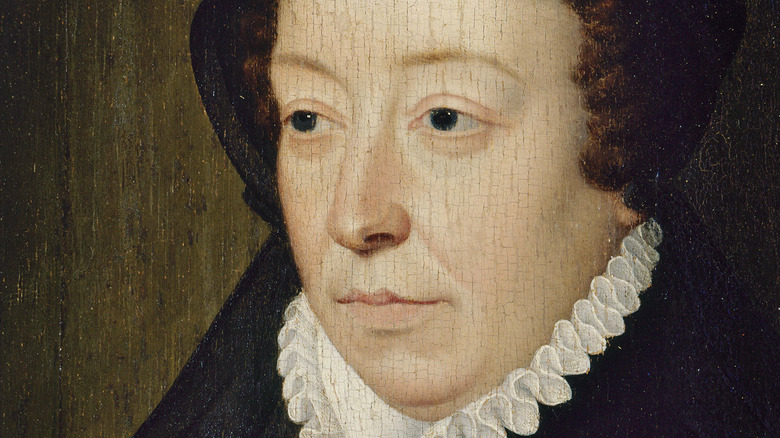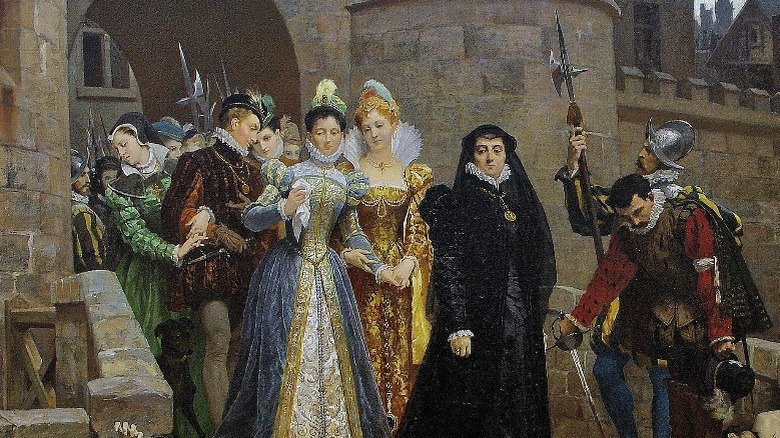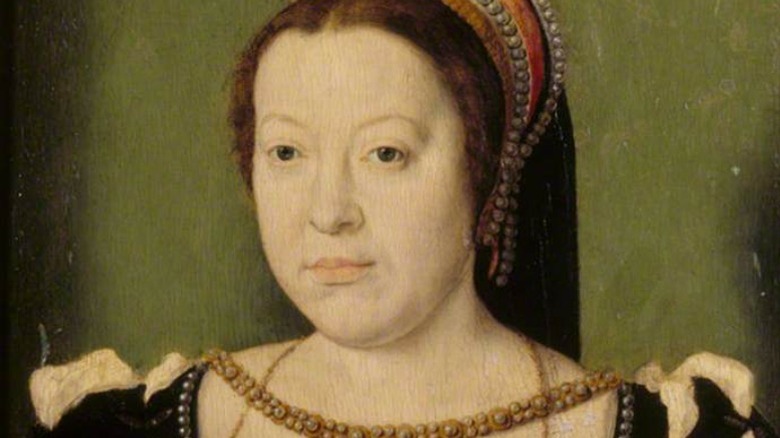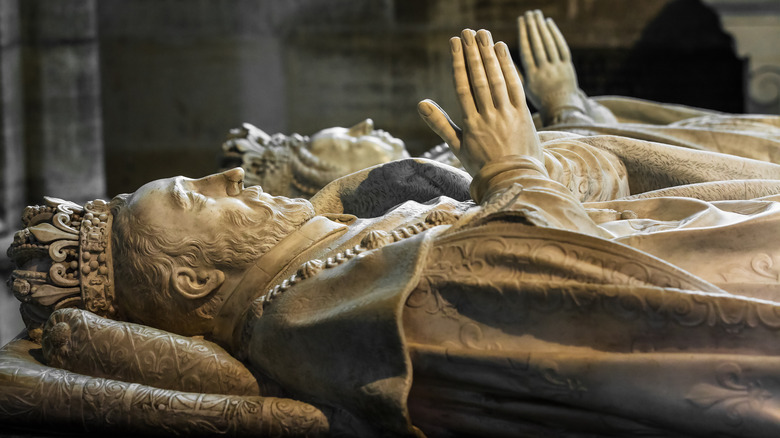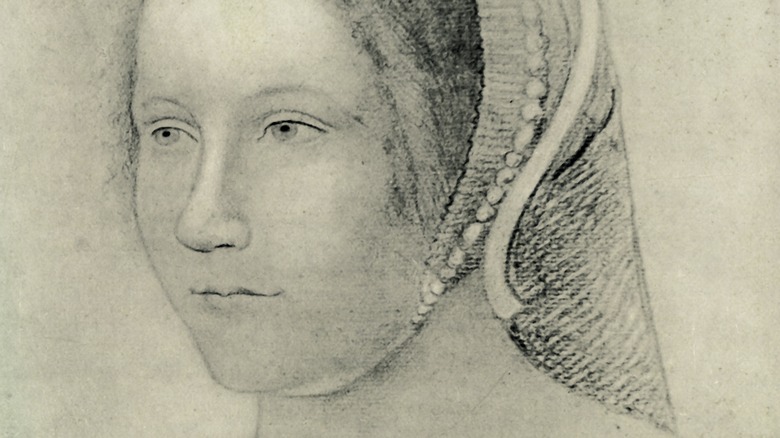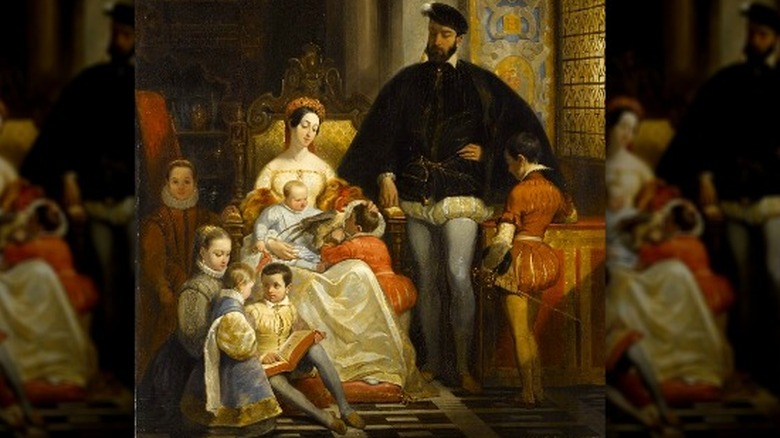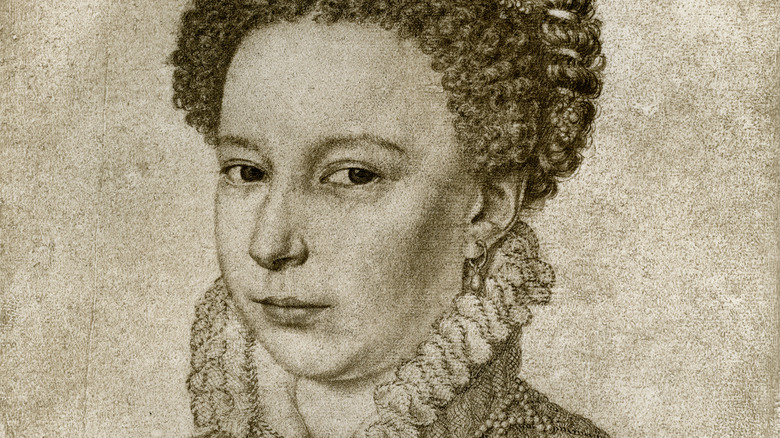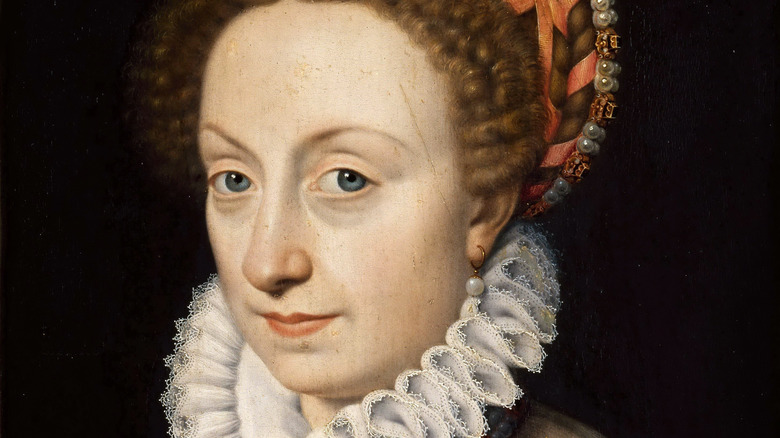The Most Gruesome Accusations Against Catherine De Medici
Few phrases of the 20th century have enjoyed more popularity than Laurel Thatcher Ulrich's observation, "Well-behaved women seldom make history" (via the Harvard Gazette). This phraseological gift from Harvard's Pulitzer Prize-winning novelist has become iconic (if often misattributed). And for anyone who's studied history, it's hard to deny the wisdom in her statement. (Even though Ulrich herself argues that the opposite should be true.)
In the context of history, many people think of historical baddies as mainly men, but most of them had nothing on Catherine de Medici, who clawed her way to the top of 16th-century French politics (via Leonie Frieda's "Catherine de Medici"). No matter what she faced — and adversity remained her constant companion — she came out top dog. During her personal game of thrones, she collected an impressive list of titles reflecting her less than well-behaved reputation: "Madame la Serpente," the "Maggot from Italy's Tomb," and the "Black Queen."
Catherine de Medici earned a reputation for being spiteful, manipulative, and downright deadly. Rumors swirled about her throughout her life, and even in death, she inspired countless gruesome accusations. While the validity of some is debated by historians, the worst of them contain more than a few kernels of truth. Read on to find out more about the so-called "Serpent Queen."
Catherine de Medici dabbled in poison as a hobby
Catherine de Medici inspired disdain among many of her subjects and even some of her children. Leonie Frieda, the author of a biography of the queen, notes, "To many, she is the very incarnation of evil." Of course, representing evil meant doing things a little differently than other royal ladies. Instead of docile pursuits like sewing, singing, or poetry, Medici dabbled in poisons. At the height of this hobby, she had a veritable "cabinet of horrors" at Chateau de Blois, according to Atlas Obscura.
Court intrigues were next level in Renaissance France, requiring a steady hand, sharp intellect, icy determination, and, apparently, untraceable homicide. In a world where naïve and weak women perished, Medici perfected the art of intimidation. If that didn't work, some say that next came poison.
As for the queen's supposed "cabinet of horrors," it is a sight to behold. Containing exactly 237 miniature cabinets, people have long attempted to explain the functionality of these compartments. Those who give Medici the benefit of the doubt say she stored papers and letters or artisanal objects within the little hidden compartments. That said, the cabinets also look remarkably convenient for storing vials of toxic stuff. Nevertheless, the verdict's still out on this one. Atlas Obscura's final assessment says it best: "Catherine definitely ordered the killing of a handful of people. But she may be innocent of poisoning, specifically."
She spied on her husband and his mistress
There were always three people in Catherine de Medici's marriage because her husband, Henry II, had a much older mistress, Diane de Poitiers (via Leonie Frieda's "Catherine de Medici"). This placed the young bride in a heartbreaking bind because she loved her husband intensely, per Frieda.
While it's hard to imagine the epitome of the "Evil Queen" truly loving anyone, such was far from the case. The poor girl fell madly in love with Henry and would cherish this affection long after his tragic death. But she had to deal with daily humiliation at the hands of both her husband and Diane de Poitiers. She had to take advice from Henry's mistress and act as though she had no knowledge of their extramarital relations. Easier said than done.
Oddly, Medici had spy holes drilled into the floor of her bedroom. According to Frieda, she used these spy holes to watch her husband and his mistress getting busy, likely at their castle at Fontainebleau. Whether she did this for sensual inspiration or to wallow in further misery, we don't know (via Jennifer Gordetsky et al.'s paper The "Infertility" of Catherine de Medici and its Influence on 16th Century France). It's a lot to unpack, and we can only imagine what would've happened if Medici ever met Sigmund Freud.
Catherine de Medici drank urine and worse
Great advances have been made when treating infertility. But in Catherine de Medici's time, treatment relied on superstition, anecdotal information, and the assumption the woman was to blame. During the first decade of her marriage to France's Henry II, Medici struggled with infertility, a dangerous situation that could've ended in divorce or something worse, per The History of Urology. (Think England's Henry VIII.)
At her lowest point, Medici threw herself on her father-in-law's mercy. Her large eyes splashing tears, she asked for exile to a convent to pass the rest of her life, but the then-king Francis I would hear nothing of it. The king had a soft spot for his daughter-in-law, having spearheaded the union in the first place. He did this despite criticism from some of his countrymen, partially because of his long-abiding affection for Italy and its culture.
With her place momentarily secured in the French royal family, Medici sought ancient prescriptions and folk remedies to induce pregnancy. She consulted a shifty crowd of diviners and magicians who asked her to do increasingly outlandish things, according to O&G Magazine. Among the tamer recommendations she followed were wearing various medals and amulets and refusing to ride mules (due to their inherent infertility). But she also tried plenty of disgusting things to ensure an heir, like drinking mule's urine by the bucket load and placing poultices of "ground stag's antlers and cow dung" on her nether regions during sex, per Leonie Frieda's "Catherine de Medici."
She earned a reputation for the 'flying squadron'
Catherine de Medici came to France at 14, and she learned very rapidly about the power a seductive woman could hold over her man from Diane de Poitiers, her husband's mistress, per History Extra. An astute observer of people and court politics, Medici soon gained a reputation for surrounding herself with the most beautiful and seductive women in France, known collectively as the "flying squadron."
All told, they numbered roughly 80, according to All That's Interesting, and she used these women as courtesan spies. As All That's Interesting puts it, "[They] were hand-picked for their charms and sexual prowess, and the court delighted in sharing tales of their sordid activities." This Renaissance squad became as infamous as the queen's other hobbies — poison and manipulation. The group also represented Medici's understanding of how to gain power as a woman. Traditional avenues were denied to her, and so she turned to the power of seduction to find out whatever she needed to know.
Medici delighted in knowing the deepest and darkest secrets of her courtiers with the very Machiavellian aim of gaining and maintaining power. Yet, she kept herself separated from these women in a unique visual way, as reported by Leonie Frieda in "Catherine de Medici." Following her husband's untimely death at the age of 41, Medici donned mourning black, never to take it off again. Yet, she had the members of her "flying squadron" clad in white, giving them a disarming, angelic air.
Catherine de Medici denied her husband's dying wish
After King Henry II took a lance to the eye during a jousting match, things quickly went from bad to worse (via All That's Interesting). Royal physicians hoped removing the splinters of wood from his eye socket, brain, temple, and throat might pave the way for recovery. But Henry II wouldn't be so lucky. Two noted physicians oversaw the court physicians, Andreas Vesalius and Ambroise Paré, but their suggestions only went so far, as reported by Acta Neurochirurgica.
Without x-rays, antibiotics, or anesthetic, the king faced an agonizing end. The medical interventions prescribed — slathering the wound with egg whites, bleeding, purging — heightened the misery and potential for infection (via Leonie Frieda's "Catherine de Medici"). Researchers still debate what killed the king. That said, the slivers still lodged in his body invited infection. Henry II endured 10 days of suffering, crying out for his mistress, Diane de Poitiers. But Catherine de Medici would have no part in fulfilling her husband's dying wish.
She banned her arch nemesis from the sick room. A court chronicler explained, "Madame ... has not entered the bedchamber since the day of the wound, for fear of being expelled by the queen" (via Leonie Frieda). But Poitiers' troubles were just beginning because following the death of Henry II, Medici had more power than ever before. And she was determined to make her husband's mistress pay for her indiscretions, according to History Today.
She barely gave her rival a chance to mourn
Henry II and Catherine de Medici were married for 26 years before his untimely death, according to Britannica. During that time, they had 10 children, with seven surviving infancy. Of course, all this history also meant that Medici spent decades living in a very awkward marriage threesome. While she'd always treated Diane de Poitiers with discreet gentility, the death of her husband meant she could dispense altogether with the superficial civility.
Following her husband's death, Catherine de Medici forced Diane de Poitiers to return the jewels Henry II had given her, per Britannica. And she made Poitiers forsake her beloved castle of Chenonceaux for the not-so-lovely Chaumont. According to All That's Interesting, Medici also used the death of her husband to turn the knife further by prohibiting the infamous mistress from attending the king's funeral. What's more, the court became an entirely unwelcoming environment for Poitiers, who found herself in exile (via History Today).
Although Medici remained above the fray of court rumors, she did betray her feelings about Poitiers years after King Henry II's death, as reported by O&G Magazine. Writing to one of her children, she observed matter-of-factly, "Never has a woman who loved her husband liked his whore." After so many years of playing second fiddle to Poitiers, Medici made sure she had the last word.
Catherine de Medici was a power-hungry mama
Diane de Poitiers famously encouraged her lover, King Henry II, to have frequent conjugal visits with Catherine de Medici, per O&G Magazine. Nevertheless, a decade would pass before the couple finally conceived Francis II. Some have wondered why Poitiers supported the king's visits with his wife, but others argue Poitiers saw it as a means to secure and maintain power.
Had Henry II divorced Medici for not producing an heir, it would've made Poitiers' future uncertain. After all, Poitiers and Medici had an uneasy understanding. But if Henry II divorced her and went looking for another wife, he might legitimately fall in love with his next spouse. Poitiers didn't want to tempt fate. But her strategy proved a dangerous calculation after Henry II was out of the picture. Medici exercised tremendous power over her children, with Francis II backing her moves against Poitiers.
This pattern of using her sons to gain and maintain political power became commonplace for Medici. What's more, she cemented her role with the title "Queen Mother of France" (via History Extra). As her sons, in turn, predeceased her, she looked to the next one to manipulate and help her stay in power, passing from Francis II to Charles IX and finally Henry III. Speaking of Medici's children, historian Nancy Goldstone argued that Charles IX and his sister Margaret formed an especially strong relationship because "they had been used and rejected [by Medici] and had bonded together in self-protection" (as quoted in "The Rival Queens").
She denied her daughter true love
You'd think with all of the tumults Catherine de Medici endured because of her arranged marriage to King Henry II, she might be understanding when it came to her own daughter, Margaret Valois (pictured), per ThoughtCo. Sadly, nothing proved further from the truth. Like her sons, Medici's daughter became little more than a pawn in her mother's political games. And not even matters of the heart could change this.
Catherine de Medici's daughter fell in love with Henry of Guise while still a teenager, and everybody knew it, including courtiers and common people. But this didn't fit in with her mother's plans for a marriage of unification with a Protestant (in order to lure all Protestant leaders to Paris). So, she forced Margaret into an arranged marriage with Henry of Navarre and had Henry of Guise banished from court.
Many people found it unfathomable that Medici would make such a move, according to Nancy Goldsmith's "The Rival Queens." After all, Henry of Guise was a catch, and the powerful Guise family would have proven a fantastic alliance. What's more, even the pope appeared to reject a mixed-faith union between Henry of Navarre and Margaret Valois. But Medici pushed forward anyway, leading some to believe she had far deeper and more calculated plans in mind.
Court rumors circled about poison gloves
The marriage between Margaret Valois and Henry of Navarre was doomed from the start. And things only got worse with the unexpected death of Jeanne d'Albret (pictured), the groom's mother, according to Atlas Obscura. Rumors of a murder plot swirled around the death, and at the center sat Catherine de Medici.
Adding fuel to the rumors were d'Albret's own recollections of how the Queen Mother of France treated her. On the few occasions the two women spoke, d'Albret claimed, "She only mocks me, and reports the contrary of what I have said to her, in order that my friends will blame me. I do not know how to deceive as she does."
But how might Medici have gotten away with such a crime? Some hypothesized she gave d'Albret a gift of perfumed gloves that secretly contained poison (via Nancy Goldstone's "The Rival Queens"). It's no surprise that people would accuse Medici of such a trick considering her predilection for deadly substances. What's more, she'd gone to great lengths to make perfumed gloves fashionable at the French court. This Italian accessory was perceived as both exotic and dangerous, not unlike Medici herself.
Catherine de Medici put out hits
In the days leading up to the forced marriage of the Catholic Catherine de Medici's daughter to a Protestant, Henry of Navarre, the Protestant community assumed reconciliation was in order, according to Britannica. But, boy, were they wrong. Instead, Medici plotted behind her son Charles IX's back to have one of his court favorites, the Protestant leader Admiral Gaspard de Coligny (pictured), and a handful of Coligny's trusted men assassinated.
Coligny proved an excellent target for Catherine de Medici because of his role as the most prominent Huguenot leader in France (via Britannica). He had also distinguished himself as a decorated military veteran by organizing a colonization plan for Huguenots in Brazil. But he would never have a chance to bring these plans to fruition.
Coligny caught Medici's attention after beating the drum to get Charles IX to declare war on Spain. To help with the endeavor, Coligny planned on raising a Huguenot unit to fight. But Medici wanted nothing to do with this, and neither did the influential Guise family. So, instead, they finagled Coligny's assassination. It took two attempts to kill Coligny, who died after being thrown from a window of his home. In the meantime, Medici worked hard to convince Charles IX that the Huguenots were openly plotting to overthrow him. Persuading her son to move against the Huguenots proved essential to the next leg of her plan ... something so gruesome and horrific that it would forever stain Medici's name.
She engineered a wedding-reception-turned-massacre
Out of all the gruesome and horrific things Catherine de Medici has been accused of, nothing beats her role in engineering the Saint Bartholomew's Day massacre (via Nancy Goldstone's "The Rival Queens"). Not only did de Medici pressure her son, King Charles IX, into calling for a massacre on Saint Bartholomew's Day, but some historians assert she used her daughter Margaret's forced marriage to ensure maximum bloodshed.
As Goldstone explains, "[The Saint Bartholomew's Day massacre] was the denouement of a carefully constructed plot that utilized the unsuspecting Margot [Margaret] as both victim and bait to lure [Gaspard de] Coligny and his faction to their doom, an intrigue planned, instigated, and executed by the one individual in France powerful enough to ensure its success: Marguerite's mother, Catherine de Medici." Just let that sink in for a moment: The queen literally planned a wedding celebration to kill half the guests.
And she got exactly what she appeared to desire in a murder spree where approximately 70,000 French Protestants (known as Huguenots) died throughout the French countryside, per History. The massacre occurred less than a week after her daughter's marriage to Henry of Navarre, which meant all the Protestant leaders and every fashionable Huguenot imaginable had gathered. The whole thing proved so outrageous, however, that Medici could always fall back on plausible deniability. Nevertheless, the massacre troubled Charles IX for the rest of his life as he regretted having given into his mother's sordid scheme, per Goldstone.
